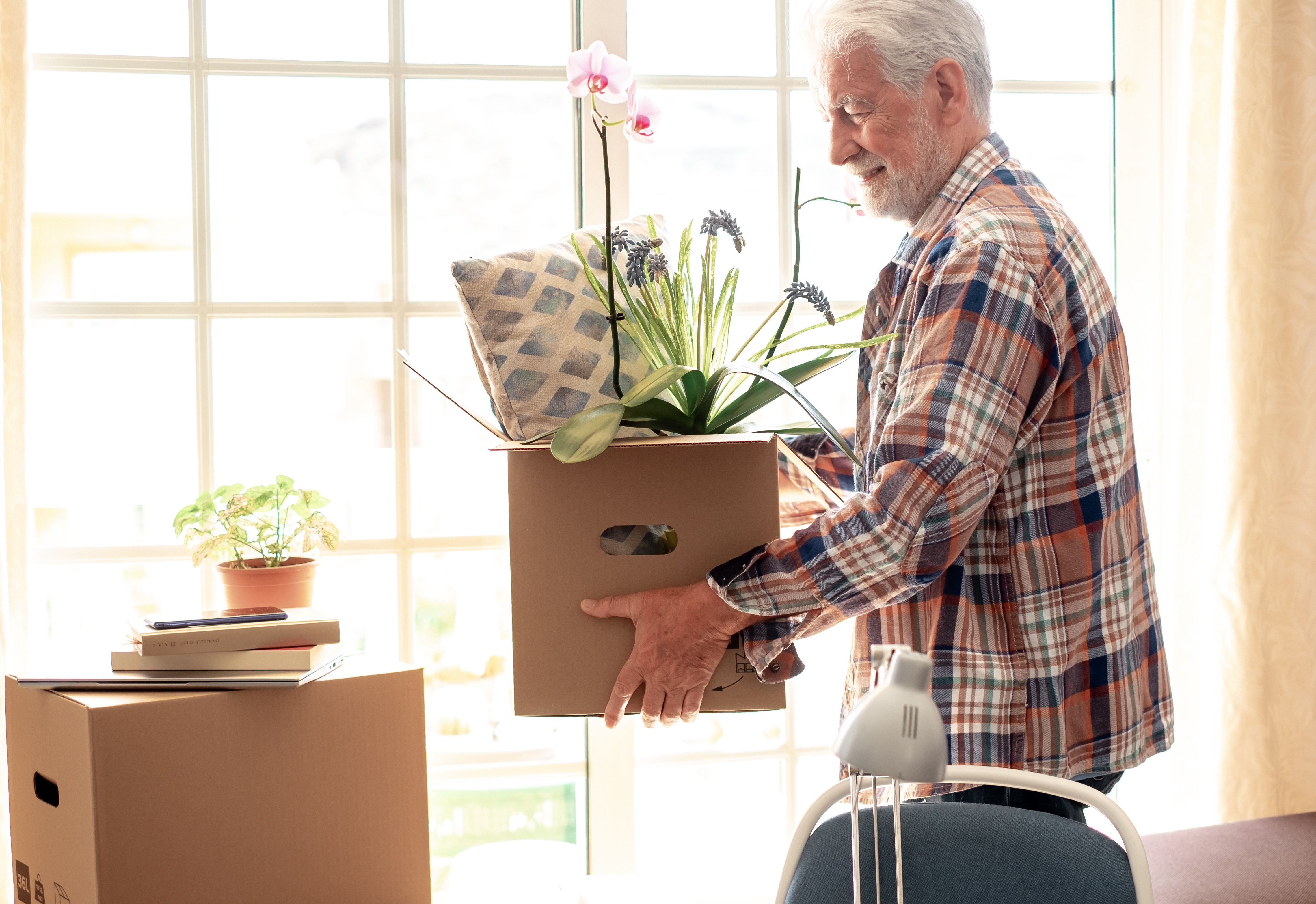Moving to assisted living: what to bring and how to prepare

Moving to assisted living can be an exciting time that also comes with its fair share of challenges. Asking yourself what’s essential, what’s important, and what you can downsize will help you have a smooth move. It can help too if you ask what furnishings your community provides, give yourself plenty of time to bring, and pack a “first day” bag. With these tips you can move with confidence and start enjoying life at your assisted living community.
So, you’ve researched assisted living communities, toured the buildings, picked out your apartment, and signed your residency agreement — Congrats! There is a lot to be excited about when you move to an assisted living community.
At the same time, you might be staring at a lifetime of possessions in your current home and feeling a little stressed about how it will fit all into your cozy new apartment. But don’t worry, to help you out we’ve put together some tips to use and questions to ask yourself as you start your next chapter.
And don’t worry, with the right preparation and a list of what to bring, you’ll become a packing pro.
Preparing for your move to assisted living
One of the best things you can do for yourself to prepare for your move is to give yourself time. Try not to leave the packing preparation to the last second.
But before you break out the cardboard boxes and packing tape, take the time for one more tour of your new community — either in person or virtually. Even if you’ve toured your assisted living community before, another visit helps refresh your memory on the community layout, what’s provided, and what you might need to bring. It can go a long way in making your plans go that much smoother.
As you do one last review before your big move, make sure you have the answers to these questions:
What furniture is provided?
Can I hang photos?
Can I have a blueprint of my room?
What services are provided?
Downsizing and what to pack for assisted living
Downsizing does not mean you need to get rid of all your belongings. It’s about taking an honest look at your stuff and focusing on what makes home feel like home.
Start with a list of what services your community provides. This will help you condense what you bring. Does your community provide meals in a dining room? You probably won’t need all your kitchen appliances and tools. Does your community offer laundry service and housekeeping? You might not need a closet full of cleaning supplies.
As you look at your belongings, also ask yourself these questions:
What do I use every day?
What holds sentimental value?
What can I live without?
Take the opportunity to toss out that box of tangled power cords or donate unwanted clothes. The sooner you begin planning, the more time you have to give things away to family and friends, bring items to thrift shops, or sell knickknacks at a yard sale. You’ll likely have plenty to pack and move — don’t move what you don’t need to move.
As you pack, however, remember it’s still important to make room for something even if you don’t absolutely need it. If that antique chicken lamp you got at a yard sale brings a smile to your face, make sure it comes with you.
What to bring and what’s provided when you move to assisted living
Here is a list you can use for your big move. It covers some of the most common things you will want to bring and what may be provided when you move into your new assisted living community:
Essential documents
Make sure these documents are packed together and are easily accessible:
Identification (license, passport)
Insurance cards (health, prescriptions)
Medical records and vaccination history
Power of attorney and legal directives
Banking and financial information
Emergency contact list
You can also leave documents with family members or store them digitally.
Furnishings
Assisted living apartments may come furnished with a bed, dresser, and a chair or they’ll be a blank slate. Depending on what’s included you’ll also want to bring:
Bedding, pillow, towels: Your assisted living community may offer laundry service, but you’ll have to bring your own linens and towels.
Small furniture: This can include nightstands, coffee tables, and recliners.
Wall décor: This is your home and you can decorate it the way you want. Make sure you bring photos, art, and other keepsakes you want to display.
Electronics: Assisted living communities don’t typically provide televisions and phone lines. You may have to bring your own.
Clothing and accessories
When packing clothes, think practically and seasonally. You’ll want to make sure you’re prepared for whatever climate you’re moving to whether it’s sunny Florida or the four seasons of New England. It can help to include:
Everyday wear
Comfortable shoes or sneakers
Seasonal outerwear (jackets, gloves, sunhats)
Undergarments, sleepwear, and slippers
A few “nice” outfits for special occasions
Your favorite jewelry or accessories
Make sure you check with your community about how laundry is handled and if you need laundry bags or tags.
Medications and health supplies
Most communities offer medication management as part of your care, but you will want to bring:
All your current prescription medications
Medical devices (hearing aids, walkers)
Copies of your prescriptions and their schedules
If your community offers in-house healthcare services, ask about transferring prescriptions and doctor visits. Many communities also offer transportation to medical appointments.
Personal care products
While assisted living communities provide support for the activities of daily living (ADLs) such as bathing, dressing, and toileting, you’ll want to make sure you pack your preferred:
Toothpaste
Soap/shampoo
Razor
Brushes
Other personal care products
Hobbies, entertainment, and other fun stuff
In his 1948 essay “Painting as a Pastime” Winston Churchill wrote, “To be really happy and really safe, one ought to have at least two or three hobbies, and they must all be real.”
While the man might not have been talking about moving to an assisted living community, his wisdom is an important reminder of how your hobbies, whether it’s watching your football team on TV, playing backgammon, or reading mystery novels, are an important part of your everyday life and should also have a space in your home.
One of the great things about moving to an assisted living community is that as you meet other residents and join community activities, you may discover a new hobby or find the opportunity to share your passion with others.
Moving day tips
Here are some tips that can help your move to your new community:
Pack an “essentials” kit: Include items that you’ll use often such as soap, toilet paper, snacks, a few changes of clothes, and other essentials that will help you from having to dig through any boxes.
Trash bag suitcase: It’s not as gross as it sounds. Poke a small hole in the bottom of a big trash bag, grab your clothes on hangers, and put the hanger hooks through the small hole. This helps keep all your clothes clean, together, and makes hanging them back up a breeze.
Label boxes: Make sure each box is labeled with what's inside and which area it should go such as your bathroom, kitchen, or bedroom.
Set up your bed first: Moving can be exhausting. Even if you don’t get completely unpacked on the first day, you’ll be happy your bed is ready for you to sleep in.
And your shower second: Unpack all your soaps, towels, and mats so they’re ready when you need them.
It’s OK to ask for help: Ask family and friends for help packing or moving.
You’ve got this
Whether you hire a moving company or enlist the help of loved ones, don't forget to give yourself time. Moving can require a lot of planning and energy, but by using our tips you’ll be joining community activities, having dinner with new friends, and enjoying all the benefits of assisted living.
How to pay for long-term care
Understand how you can pay for life at an assisted living community and other types of long-term care with our guide.







